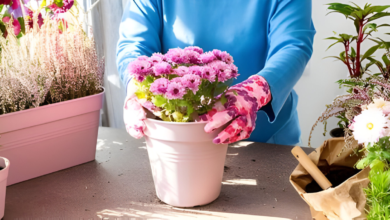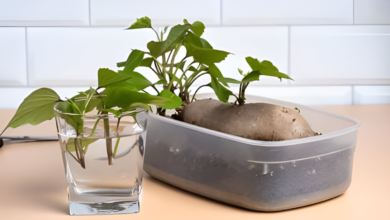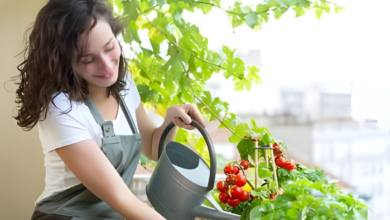10 Tips for Successfully Growing Beefsteak Tomatoes in Containers

Here’s an overview:
- Choosing the Right Pot Size
- Selecting the Right Tomato Variety
- Preparing the Potting Mix
- Planting Beefsteak Tomato Seeds
- Watering and Fertilizing
- Providing Adequate Support
- Pruning and Training Your Tomato Plants
- Managing Pests and Diseases
- Harvesting and Enjoying Your Beefsteak Tomatoes
- Troubleshooting Common Issues
Choosing the Right Pot Size
When growing beefsteak tomatoes in containers, selecting the correct pot size is crucial. A container that is too small can restrict root growth and lead to stunted plants and decreased fruit production. On the other hand, an excessively large container can hold too much moisture, causing root rot.
Here are some guidelines to help you choose the right pot size for your beefsteak tomatoes:
- Minimum 5-gallon Pot: I recommend using a minimum 5-gallon container for each beefsteak tomato plant. This size provides enough space for root development and allows the plant to access an adequate water supply without the risk of waterlogged soil.
- Bigger is Better: If possible, opt for even larger containers, such as 10-gallon or 15-gallon pots. The extra space allows the roots to spread out and provides more stability for the plant as it grows taller and heavier with fruit.
- Consider Planting Multiple Tomatoes: If you plan to grow multiple beefsteak tomato plants, ensure each plant has enough space by using larger containers or spacing them adequately in a single large container.
- Drainage Holes are a Must: Whatever size pot you choose, make sure it has sufficient drainage holes at the bottom to prevent waterlogging. Proper drainage is essential for healthy tomato plants.
- Quality over Quantity: Invest in high-quality, durable containers that will last for several growing seasons. Look for pots made from materials like terracotta or plastic that can withstand outdoor conditions.
Selecting the right pot size is the first step in setting up your beefsteak tomatoes for success in containers. Providing adequate space for root growth and ensuring proper drainage will help your plants thrive and produce bountiful harvests.
Selecting the Right Tomato Variety
When choosing a tomato variety for container gardening, I always consider the space available, sunlight exposure, and personal preference. Here are some tips to help you select the right tomato variety:
- Determinate vs. Indeterminate: Determine whether you want a determinate or indeterminate variety. Determinate tomatoes grow to a certain height and set fruit all at once, making them ideal for compact spaces. Indeterminate varieties keep growing and producing fruit throughout the season, requiring more support but offering a continuous harvest.
- Container Size: Consider the mature size of the tomato plant when selecting a container. Larger varieties like beefsteak tomatoes require bigger pots to accommodate their extensive root systems and support their growth.
- Sunlight Requirements: Choose a tomato variety that matches the sunlight conditions of your gardening space. Beefsteak tomatoes typically require at least 8 hours of direct sunlight daily for optimal growth and fruit production.
- Climate Suitability: Ensure the tomato variety you select is suitable for your climate zone. Beefsteak tomatoes thrive in warm weather, so if you live in a cooler climate, consider growing them in a greenhouse or choose a variety better suited to lower temperatures.
- Disease Resistance: Look for tomato varieties that are resistant to common diseases like blight or wilt. Opting for disease-resistant varieties can help prevent issues in the long run and ensure a successful harvest.
- Flavor Profile: Consider the flavor profile of the tomato variety. Beefsteak tomatoes are known for their rich, sweet taste, making them a popular choice for culinary use. However, personal preference plays a significant role, so choose a variety that aligns with your taste preferences.
By considering these factors when selecting a tomato variety for container gardening, you can set yourself up for a successful and flavorful harvest.
Preparing the Potting Mix
I always start with a high-quality potting mix when growing beefsteak tomatoes in containers. Here are some key tips for preparing the perfect potting mix:
- Choose a Well-Draining Mix: Opt for a potting mix specifically designed for containers to ensure proper drainage. This is crucial to prevent waterlogged roots, which can lead to disease and poor growth.
- Add Organic Matter: To boost fertility, I mix in some well-rotted compost or aged manure. This helps provide essential nutrients to the tomato plants as they grow.
- Incorporate Perlite or Vermiculite: Adding perlite or vermiculite to the potting mix improves aeration and drainage. This is especially important for beefsteak tomatoes, as they require good air circulation around their roots.
- Avoid Garden Soil: I steer clear of using garden soil in container mixes, as it tends to compact in containers, restricting root growth and drainage.
- Consider Coconut Coir: Coconut coir is an eco-friendly alternative to peat moss that helps retain moisture in the potting mix. I often use it to maintain consistent soil moisture.
- Include Slow-Release Fertilizer: To ensure a steady supply of nutrients for my beefsteak tomatoes, I mix in a slow-release fertilizer into the potting mix. This provides balanced nutrition for healthy plant growth.
- Use a pH-Adjusted Mix: Checking and adjusting the pH of the potting mix can help optimize nutrient uptake by the tomato plants. A slightly acidic pH level around 6.0 to 6.8 is ideal for beefsteak tomatoes.
By following these steps and preparing a nutrient-rich, well-draining potting mix, I set up my beefsteak tomatoes for success in containers.
Planting Beefsteak Tomato Seeds
I begin the process of growing beefsteak tomatoes by planting the seeds. Here are the steps I follow to ensure successful seed planting:
- Selecting the Right Container: I choose a container that is at least 18 inches in diameter to provide enough space for the beefsteak tomato plants to grow.
- Using Quality Seed Starting Mix: I fill the container with a high-quality seed starting mix that is well-draining to prevent waterlogging.
- Planting the Seeds: I plant the beefsteak tomato seeds about 1/4 inch deep in the soil, ensuring they are evenly spaced apart.
- Providing Proper Watering: After planting the seeds, I water the soil thoroughly to ensure it is evenly moist but not soaked.
- Maintaining Optimal Temperature: I place the container in a warm location with temperatures around 70-80°F to encourage seed germination.
- Ensuring Adequate Light: Beefsteak tomato seeds require plenty of sunlight to sprout, so I place the container in a sunny spot or provide artificial grow lights.
- Thinning Out Seedlings: Once the seedlings emerge, I thin them out to ensure each plant has enough space to grow properly.
- Transplanting Seedlings: When the seedlings have developed their true leaves, I transplant them into individual larger containers or into the garden if the outdoor conditions are favorable.
By following these steps, I set a solid foundation for my beefsteak tomato plants to thrive and produce an abundant harvest.
Watering and Fertilizing
I make sure to water my beefsteak tomatoes consistently to keep the soil moist but not waterlogged. This helps prevent issues like blossom end rot. I usually water them deeply once or twice a week, depending on the weather.
- Consistent watering: It’s crucial to water your beefsteak tomatoes regularly, especially during hot summer months.
- Deep watering: I prefer to water deeply to encourage the roots to grow downwards and become more resilient.
- Mulching: Adding a layer of mulch around the base of the plants helps retain moisture and reduce water evaporation.
- Fertilizing: I feed my beefsteak tomatoes with a balanced fertilizer every 2-3 weeks during the growing season.
- Organic fertilizers: I opt for organic fertilizers to promote healthy growth without the risk of chemical buildup in the soil.
- Avoid over-fertilizing: Too much fertilizer can lead to excessive foliage growth at the expense of fruit production, so I make sure to follow the recommended dosage.
By maintaining a regular watering schedule and providing adequate nutrients through fertilization, I ensure that my beefsteak tomatoes grow vigorously and produce an abundance of delicious fruits.
Providing Adequate Support
I have found that beefsteak tomato plants can become quite heavy with the weight of their fruit, so providing adequate support is essential to prevent them from bending or breaking. Here are some tips for supporting your beefsteak tomato plants effectively:
- Sturdy stakes: Invest in sturdy stakes made of materials like wood or metal to support the weight of the tomato plants. Secure the stakes firmly in the container to provide a strong support structure.
- Trellis or cage: Consider using a trellis or cage to support the tomato plants as they grow taller. This will help prevent the plants from sprawling out and keep them more compact.
- Tying the plants: As the tomatoes grow, gently tie them to the stakes or trellis using soft plant ties. Be careful not to tie them too tightly to allow room for growth.
- Pruning: Regularly prune the lower leaves and suckers of the tomato plants. This will help improve air circulation and light exposure, leading to healthier plants.
- Mulching: Apply mulch around the base of the tomato plants to help retain moisture and regulate soil temperature. This will create a more stable environment for the plants to grow.
- Regular monitoring: Keep an eye on the tomato plants as they grow and adjust your support system as needed. Check for any signs of bending or leaning and make adjustments accordingly.
By providing adequate support to your beefsteak tomato plants, you can help them grow more vigorously and produce an abundant harvest of juicy, flavorful tomatoes.
Pruning and Training Your Tomato Plants
Pruning and training your tomato plants are essential steps to ensure healthy growth and maximum fruit production. Here are some tips to help you get the best yields from your beefsteak tomatoes:
- Remove suckers: Suckers are small shoots that grow in the crotch between the main stem and branches. By removing these suckers, you direct the plant’s energy toward fruit production rather than foliage growth.
- Support your plants: Beefsteak tomatoes are heavy fruit producers, so they require sturdy support. I recommend using cages or stakes to help the plants grow upright and prevent the heavy fruits from weighing down the branches.
- Prune for airflow: Proper airflow is crucial to preventing diseases like blight. I prune the lower leaves of my tomato plants to improve airflow and reduce the risk of infections.
- Train your plants: As the tomato plants grow, I gently train the main stems along the support structure to keep them upright. This helps distribute nutrients evenly and promotes better fruit development.
- Top off your plants: When your tomato plants reach the desired height, I top them off by pinching the growing tip. This encourages the plant to focus on fruit production rather than growing taller.
- Regular maintenance: Check your plants regularly for any signs of disease or pest infestation. By catching issues early, you can prevent them from spreading and harming your tomato crop.
By following these pruning and training techniques, you can help your beefsteak tomato plants thrive and produce a bountiful harvest.
Managing Pests and Diseases
When it comes to growing beefsteak tomatoes in containers, managing pests and diseases is crucial to ensure a successful harvest. Here are some tips to help you keep your plants healthy:
- Inspect Regularly: Make it a habit to inspect your tomato plants regularly. Look for any signs of pests like aphids, caterpillars, or mites, as well as symptoms of common diseases such as blight or leaf spot.
- Natural Predators: Encourage natural predators in your garden to help control pests. Ladybugs, lacewings, and praying mantises can be beneficial allies in your battle against harmful insects.
- Neem Oil: Consider using neem oil as a natural pesticide. It is effective against a wide range of pests and is safe to use on edible plants like tomatoes.
- Pruning: Keep your tomato plants well-pruned to improve air circulation. This can help prevent the development of fungal diseases like powdery mildew.
- Mulching: Mulch around the base of your tomato plants to help regulate soil temperature and moisture levels. Mulch can also act as a barrier against soil-borne diseases.
- Rotate Crops: If you’re reusing containers for planting tomatoes, rotate your crops each season. This can help prevent the buildup of pests and diseases in the soil.
- Organic Fertilizers: Use organic fertilizers to feed your tomato plants. Chemical fertilizers can sometimes make plants more susceptible to diseases.
- Watering: Avoid overhead watering, as this can promote the spread of diseases. Instead, aim to water the soil directly at the base of the plants.
- Quarantine Infected Plants: If you notice any signs of pests or diseases on one of your tomato plants, quarantine it immediately to prevent further spread to other plants.
- Stay Vigilant: Lastly, stay vigilant throughout the growing season. Early detection and prompt action are key to effectively managing pests and diseases in your container-grown beefsteak tomatoes.
Harvesting and Enjoying Your Beefsteak Tomatoes
I can’t wait to start harvesting and enjoying the fruits of my labor! When it comes to harvesting beefsteak tomatoes, there are a few key things to keep in mind to ensure you have a bountiful harvest and delicious tomatoes to enjoy.
- Timing is Key: When harvesting your beefsteak tomatoes, make sure they are fully ripe. This is when the tomatoes are firm and have developed their full color. Avoid picking them too early as they won’t have the best flavor.
- Harvesting Technique: To harvest your beefsteak tomatoes, simply grasp the fruit and twist it gently until it comes off the stem. Be careful not to squeeze or damage the tomato.
- Storage: If you have more tomatoes than you can eat right away, you can store them at room temperature, out of direct sunlight. Just be sure to use them within a few days to enjoy them at their best.
- Enjoying Your Harvest: There are endless ways to enjoy your beefsteak tomatoes. From classic caprese salads to fresh tomato sandwiches, the possibilities are endless. I can’t wait to savor the juicy, flavorful tomatoes I’ve grown myself.
Remember, the joy of growing beefsteak tomatoes in containers doesn’t end with the harvest. Take the time to enjoy the fruits of your labor and share them with family and friends. Happy harvesting!
Troubleshooting Common Issues
When growing beefsteak tomatoes in containers, I have encountered a few common issues that can hinder their growth and overall health. Here are some troubleshooting tips to address these issues:
- Yellowing Leaves: If you notice the lower leaves of your beefsteak tomato plant turning yellow, it could be a sign of nutrient deficiency. Try feeding the plant with a balanced fertilizer to provide the necessary nutrients.
- Wilting Plants: Wilting can be caused by underwatering or overwatering. Check the moisture level of the soil regularly and adjust your watering schedule accordingly. Make sure the container has proper drainage to prevent waterlogging.
- Pests and Diseases: Keep an eye out for common pests like aphids, whiteflies, and tomato hornworms. If you notice any signs of infestation, promptly treat the plants with insecticidal soap or neem oil. Also, prevent diseases like blight by ensuring good air circulation around the plants.
- Stunted Growth: If your beefsteak tomatoes are not growing as expected, they may be lacking sunlight. Make sure the container is placed in a sunny location with at least 6-8 hours of direct sunlight daily.
- Blossom End Rot: This common issue is caused by a calcium deficiency in the plant. To prevent blossom end rot, maintain consistent soil moisture levels and ensure the plant receives adequate calcium through proper fertilization.
By addressing these common issues promptly, I have been able to successfully grow healthy and productive beefsteak tomatoes in containers. Remember to observe your plants regularly and take action as soon as any issues arise to ensure a bountiful harvest.




